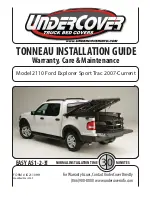
start-o gradeability, will decrease with
increasing elevation.
Coupling/uncoupling a tr
Coupling/uncoupling a trailer
ailer
Coupling a tr
Coupling a trailer
ailer
*
NO
NOTE
TE Damage to the vehicle battery due
to full discharge
Charging the trailer battery using the power
supply of the trailer can damage the vehicle
battery.
#
Do not use the vehicle's power supply to
charge the trailer battery.
#
Shi the selector lever to position
j
.
#
Apply the vehicle's parking brake.
#
Close all the doors.
#
Position the trailer on a level surface behind
the vehicle.
%
The ball head height changes depending on
the vehicle's load. In this case, use a trailer
with a height-adjustable trailer drawbar.
#
Couple up the trailer.
#
Establish all electrical and other connections
to the trailer.
#
Remove objects or devices which prevent the
trailer from rolling, e.g. wheel chocks.
#
Release the trailer's parking brake.
%
The vehicle harness has a cable connection to
the brake light indicator lamp.
Observe the maximum permissible trailer dimen-
sions (width and length).
Most US states and all Canadian provinces pre-
scribe the following points, and you are urgently
recommended to comply with these:
R
Safety chains between the towing vehicle and
the trailer. The chains should be routed in a
criss-cross pattern under the trailer drawbar.
They must be connected to the trailer tow
hitch and not to the bumper or to the vehicle
axle.
Leave su cient slack in the chains. This allows
for even sharp cornering.
R
A separate brake system is required for certain
trailers.
R
A safety feature is required for braked trailers.
Determine the speci c requirements according
to the relevant laws.
If the trailer becomes detached from the tow-
ing vehicle, the safety feature triggers the
trailer brakes and can thus reduce the danger.
UUncoupling a tr
ncoupling a trailer
ailer
&
W
WARNING
ARNING Risk of being crushed and
becoming trapped when uncoupling a
trailer
When uncoupling a trailer with an engaged
inertia-activated brake, your hand may become
trapped between the vehicle and the trailer
drawbar.
#
Do not uncouple trailers with an engaged
overrun brake.
Do not uncouple a trailer with an overrun brake in
a state of overrun. Otherwise, the rebound of the
overrun brake can damage your vehicle.
#
Shi the selector lever to position
j
.
#
Apply the vehicle's parking brake.
#
Close all the doors.
#
Apply the trailer's parking brake.
#
Secure the trailer against rolling away with a
wheel chock or similar object.
#
Remove the trailer cables and safety chains.
#
Uncouple the trailer.
Inf
Infor
ormation about to
mation about towing a tr
wing a trailer
ailer
Operating a trailer is subject to many statutory
regulations such as speed restrictions.
Many states also require an auxiliary separate
functional braking system when towing a weight
that exceeds a certain limit. For your safety, it is
recommended to use a separate functional braking
system on any towed vehicle.
Make sure that your trailer combination meets
local regulations. This not only applies to your
place of residence, but also to your destination.
Information on this can be obtained from the
police and local authorities.
Comply with the following when driving with a
trailer:
R
Practice cornering, stopping and backing up in
a tra c-free location. In this way, you will gain
Driving and parking 165
165
















































